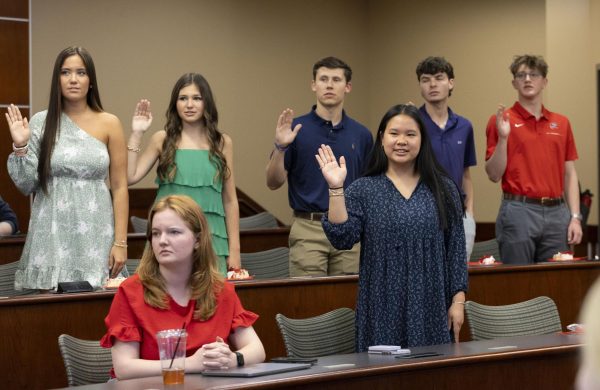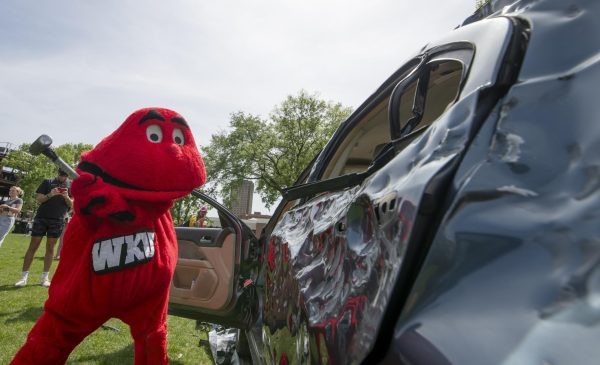WKU professor recovering after a fall in the Himalayas
May 20, 2014
WKU geology professor John All is in stable condition after being rescued from Mount Himlung after falling down a 70-foot crevasse.
Clinton Lewis, a WKU staff photographer and All’s friend, provided updates on All’s condition. Lewis has accompanied All on trips to study climate change in mountain environments.
All sustained injuries while attempting to establish a second base camp further up the 23,497 foot mountain in the Annapurna region of Nepal.
“He was at around 19,000 feet establishing camp two while the rest of the team was down at camp one when the accident happened,” Lewis said.
All survived a 70-foot fall down a crevasse, according to the American Climber Science Program. However, All did receive injuries, such as a broken arm, ribs and internal bleeding. Despite this, All managed to climb out of the crevasse using two ice axes and return to camp two, where he awaited rescue.
All said the nature of the situation made it hard to climb out.
“Because I had the broken arm and broken ribs and internal injuries and bleeding and everything, it was extremely difficult to climb out,” All said. “It would have been difficult to climb out even if I was whole. I mean a crevasse is a very crazy place to be. It’s sort of like an ice cave. And to try and climb out of an ice cave upside down is really difficult. And to do it with only part of your body functioning and bleeding internally and getting hypothermic so forth made it extremely difficult.”
During his climb out of the crevasse, All recorded a video of his efforts. All said he did this both for documentation purposes and to help explain what had happened.
“I wanted to be able to explain to people what had happened,” All said. “I mean like my mom and my friends and stuff, you know I can tell them I fell into a crevasse and that doesn’t mean anything to them. They’ve never been in a crevasse before.”
All estimated it took “four or five” hours to climb out.
Lewis explained that crevasses can be treacherous to climbers. They can become covered with snow, making them easy to fall through. All said the mountain he was climbing wasn’t historically known for containing crevasses and falling down one was something he wasn’t suspecting.
“…To have this sort of sudden change from walking along to falling down a black pit, smashing my face against the sides of the crevasse and so forth, was a shocking change,” All said.
All was able to communicate that he had had an accident and needed help through a GPS communicator.
Initially, the rescue effort via helicopter was delayed due to weather. This left All alone at camp two until the following morning. Lewis credited All’s medical training and good health.
“If he could get to his tent, and he could relatively stay stable, then he would be fine,” Lewis said. “If anybody can weather it, it’s him, just ’cause he’s physically huge and extremely fit. He knows how to take care of himself.”
All said he is no stranger to climbing mountains, doing it for more than two decades. His previous experiences include climbing Mount Everest and Mount McKinley, the highest point in the United States.
All said he was extremely lucky he survived and the fear of dying kept him motivated to climb out.
“I should have already been dead,” All said. “You don’t survive falling down a crevasse.”
After an avalanche on Mount Everest claimed the lives of 16 Sherpas last month, the 2014 climbing season was cancelled.
“The objective peak in Nepal was Lhotse, which is connected to Mount Everest,” Lewis said. “You have to climb half of Everest right through that region to get to the mountain that was their target.”
Because of this, All returned to Kathmandu, the capital of Nepal, to figure out another objective for their expedition. All worked with a Nepalese guiding company to relocate the expedition to Mount Himlung in the Annapurna region of Nepal, Lewis said.
All and Lewis first became friends before All’s first trip to Nepal in 2010. Lewis accompanied All on two trips to Peru to photograph his research.
“He conducts research to assess the effects of climate change,” Lewis said.
Researchers accomplish this by taking snow samples at various depths to measure dust and black carbon residue on the snow.
“The more black carbon or dust or any kind of residual matter on the snow lessens the reflectivity of the snow and ice, thus making it melt faster,” he said.
Human activity can cause these deposits to build up faster, Lewis said.
“It accelerates the retreat of a glacier,” he said. “Especially in Nepal and in Peru; that’s pretty much the only source of drinking water for those regions.”
The American Climber Science Program is under the American Alpine Club and hosts annual expeditions to the Cordillera Blanca range in the Andes Mountains.
All is the director of the program and is currently recovering in the Norvic International Hospital in Kathmandu. Lewis is glad to know that his friend is pulling through.
“No matter how experienced you are, when you can’t see a danger it gets the best of them,” he said.
All, whose accident has been covered by numerous news organizations such as the Huffington Post and CNN, said he doesn’t think much of it.
“It doesn’t really mean much to me one way or another,” All said. “One thing is I’m here in Kathmandu and there’s no TV here or anything, so I don’t perceive any media attention.”
All said he would eventually have to fly back to the United States to get surgery on his arm. He also plans to go to Peru in the coming weeks for a research expedition.
All said he hopes that his accident doesn’t discourage others from mountain climbing.
“Don’t think it’s a common occurrence,” All said. “It’s just one of those really incredibly bad luck sort of things.”





















![Students cheer for Senator at Large Jaden Marshall after being announced as the Intercultural Student Engagement Center Senator for the 24th Senate on Wednesday, April 17 in the Senate Chamber in DSU. Ive done everything in my power, Ive said it 100 times, to be for the students, Marshall said. So, not only to win, but to hear that reaction for me by the other students is just something that shows people actually care about me [and] really support me.](https://wkuherald.com/wp-content/uploads/2024/04/jadenmarshall-600x422.jpg)

